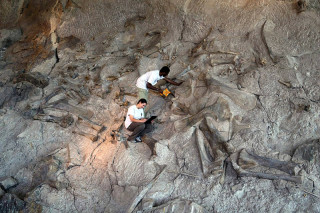Explorer Corps Marker: Uintah County
Find the Marker
The Uintah County marker is on the lawn next to the dinosaurs at 200 East Main Street in Vernal. It highlights Dinosaur National Monument, about 20 minutes east in Jensen.
GPS 40°27’21.3228”N 109°31’27.462”W
Dig Deeper
Utah is full of dinosaur hotspots. The southern and eastern parts of the state are rife with fossil-rich rock layers that have provided a stunning look at almost the entire Age of Dinosaurs. But as far as dramatics go, it’s hard to beat the beauty of Dinosaur National Monument.
Located in northeastern Utah, and spilling over into Colorado, Dinosaur National Monument is a stunning landscape of exposed stone, skyscraper-tall canyons, whitewater rivers, and high desert. But what really put this place on the map goes back to a chance discovery more than a century ago.
“In the summer of 1909,” Dr. Randall Irmis, NHMU's chief curator and curator of paleontology says, “paleontologist Earl Douglass from the Carnegie Museum in Pittsburgh, Pennsylvania came to Utah to look for dinosaur fossils.” The museum needed a showstopper, a big, long-necked one to wow audiences on the East Coast. They had no idea that Douglass was about to hit the Jurassic motherlode. “That summer,” Irmis says, “Douglass found eight dinosaur vertebrate from the tail of a sauropod dinosaur called Apatosaurus.” As Douglass began excavating that find, he kept finding more – an entire boneyard of dinosaurs that had perished and become buried more than 148 million years ago.

Many of the bones and skeletons Douglass uncovered went back to the East Coast. The long-lost skull of Apatosaurus – once called “Brontosaurus” – and the near-complete skeleton of a young, long-necked Camarasaurus were among the finds. But Douglass didn’t want to dig up the entire quarry. He had a dream that the remainder of the quarry could be left in-place so that visitors could come see the jumbles of bones in the rock they were preserved in, already tilted at a 67 degree angle. Douglass got his wish when the area around the quarry was protected as Dinosaur National Monument in 1915, which was later expanded from 80 to 210,844 acres in 1938 to preserve the natural wonders around the quarry.
More than a century of fieldwork and study has led paleontologists to understand that the famous Carnegie Quarry was once part of a Jurassic floodplain. This was a lowland habitat with stands of conifers alongside river channels. Dinosaurs would often die in the vicinity of these channels, perhaps even during seasonal droughts. When the rains returned, their bodies and bones were washed together in one great log jam – the bodies of some dinosaur giants even helped trap those of others.
As spectacular as the Carnegie Quarry is, Irmis notes, “this site shouldn’t get all the attention.” Even from a fossil perspective, Dinosaur National Monument is full of wonders outside the quarry. The first skeleton of the recently-named Allosaurus jimmadseni was found near the Carnegie Quarry, as well as a long-necked, Early Cretaceous dinosaur called Abydosaurus mcintoshi. Explorations of other nearby rock layers of different ages have turned up coil-shelled squid relatives called ammonites, the tracks of weasel-like protomammals, bones of shark-like marine reptiles called ichthyosaurs, and tracks made by early meat-eating dinosaurs.
The Natural History Museum of Utah has explored some of these sites. In addition to historic efforts at the Carnegie Quarry – including the excavation of a near-complete Allosaurus – from 2011 to 2014 museum paleontology staff, students, and volunteers searched Dinosaur National Monument for Triassic fossils from about 210 million years ago. The team found many trace fossils of animals that lived in those ancient environments, Irmis notes, which is important for understanding how this particular spot on the Late Triassic map differed from those in Arizona, New Mexico, and elsewhere in Utah. Dinosaur National Monument still has many secrets to tell.
Want to Go Farther?
Dinosaur National Monument boasts an abundance of trails, as well as opportunities for rafting and camping.